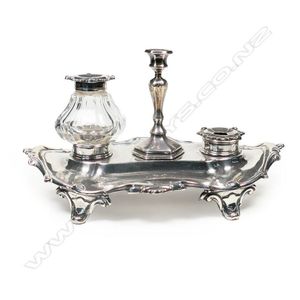Victorian Silver Desk Standish with Inkwell and Taper Stick
A Victorian silver desk standish, by Henry Wilkinson & Co., Sheffield 1856. 333gm, the scrolling oval tray with facetted glass inkwell, baluster taper stick and lidded ponce pot., a noted
You must be a subscriber, and be logged in to view price and dealer details.
Subscribe Now to view actual auction price for this item
When you subscribe, you have the option of setting the currency in which to display prices to $Au, $US, $NZ or Stg.
This item has been sold, and the description, image and price are for reference purposes only.
- Standish - Although the word is little used nowadays, a standish is an inkstand on feet and usually in silver or silver plate, containing some of the following: inkwells, a pounce pot, a sealing wax container and a pen rest. Standishes are also found in less common materials including boulle, marble, brass and wood.
- Victorian Period - The Victorian period of furniture and decorative arts design covers the reign of Queen Victoria from 1837 to 1901. There was not one dominant style of furniture in the Victorian period. Designers used and modified many historical styles such as Gothic, Tudor, Elizabethan, English Rococo, Neoclassical and others, although use of some styles, such as English Rococo and Gothic tended to dominate the furniture manufacture of the period.
The Victorian period was preceded by the Regency and William IV periods, and followed by the Edwardian period, named for Edward VII (1841 ? 1910) who was King of the United Kingdom and the British Dominions and Emperor of India for the brief period from 1901 until his death in 1910. - Faceting - Faceting is a technique of removing material from a curved surface, to give a series of flat surfaces but retaining the profile of the original surface.
The technique is most commonly associated with diamond cutting where the various cuts used such as rose cut and brilliant cut, add life and sparkle to the stone, whilst at the same time removing as little of the stone as possible.
Faceting by grinding is also used to decorate glass. The stems of many drinking glasses are decorated by cutting a series of flat surfaces on a circular stem, and hollow vessels such as vases may have faceted surfaces.
In furniture faceting is often applied to legs of tables and chairs, where a circular baluster shaped section is flattened so as to form an octagonal section.
This item has been included into following indexes:
- desk standish (inkstand) 60
-
ink stands
- silver items 127
- silver plate items 77
-
ink wells / ink stands, material
- glass objects 225
- silver items 297
- ink wells / ink stands, period or age - Victorian 85
- taper sticks (small candlesticks) 20
